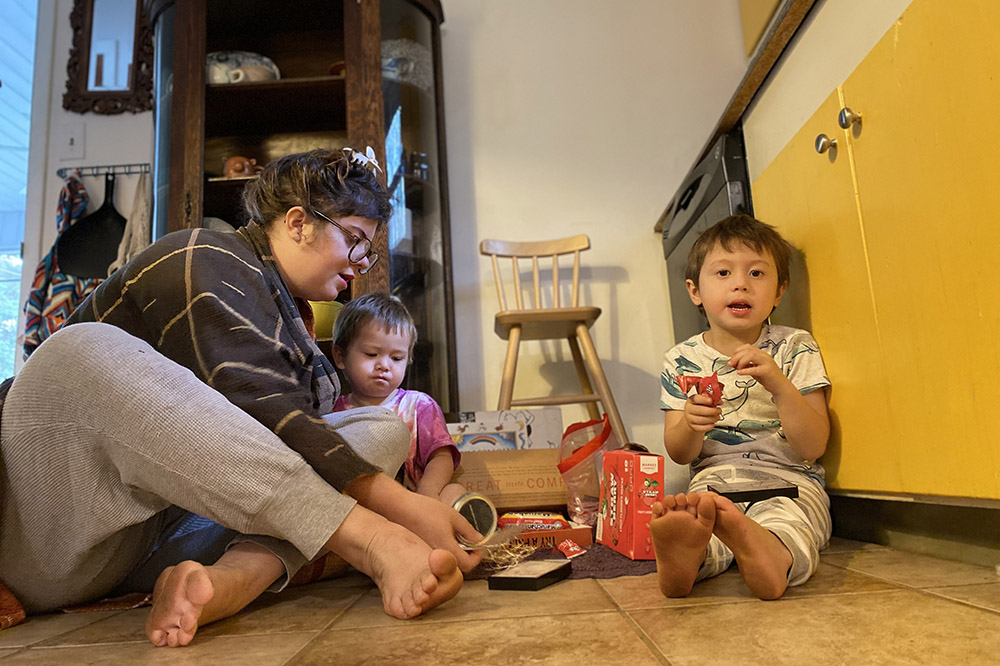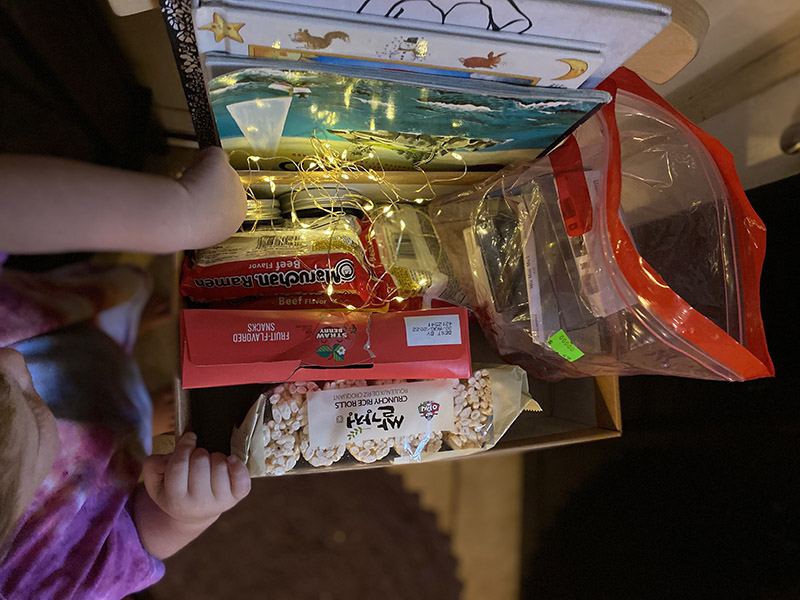Mom Talk: Planning For A Natural Disaster (With Kids)
Posted by admin on

I wake up in the middle of the night sweating with fear that my children will spend a lot of time feeling afraid—of people, or safety, or life. Unhelpful, but it sometimes chokes me. My maternal danger instinct feels like a flickering lightbulb all the time lately. I’ve read so many articles about this really hard time we are having, us moms who worked from home while homeschooling and providing childcare, as well as doing tech support, best-effort-therapist and best-friend-to-lonely-kid duties.
Now we are also the emergency caretakers during climate change natural disasters (give yourself a small, weak cheer). Every time I open up social media, someone I know is watching alerts for an incoming storm. It’s been hard for me as a parent and person to know how to respond to all of these disasters, especially when my co-parent still has to go off to work in rain or shine and I am the only other adult I talk to all day.
A partial list of climate change events our family has suddenly had to improvise around includes seventeen (spread out) days without power in the autumn before COVID, two weeks evacuated from our home due to wildfires, a tree-felling, house-crushing nighttime windstorm, and a flood. Now when a weather alert pops up, it’s hard for me to know whether to go on as usual or quickly make a worst-case scenario plan.
If I sit down to write some sort of recap of what it was like when we evacuated the home we shared with my parents and our three kids in the Santa Cruz mountains to flee rapidly spreading wildfires, my brain sort of freezes into a series of surreal still-frame memories: ash like snow on our decks and vehicles, the trunk of our car filled with sleeping bags and duffels like a macabre camping trip send-off, myself hiking to the top of our hill to scan for flames, my dad silhouetted in smoke with a chainsaw. I felt calm and frozen, thankful that my brain was disassociating from the crushing fear while moving between sudden action and numb waiting.
For weeks after we drove away, I fielded a surge of critical information rushing in on my phone but was still responsible for coaxing a 1-, 3-, and 5-year-old through meals and books and exercise, finding groceries, masking my uncertainty so they weren’t afraid like I was.
Eighteen months later, our kids sometimes tell me about the fun time when we got to stay at all those different houses and watch a lot of Octonauts. I tell myself this means we made it through with minimal trauma. But the extreme stress of leaving a home truly believing we would never return to it hasn’t left me. A lot of days it’s hard for me to find some hope for the Earth’s future, or the meaning and joy in raising a family in the midst of what feels too much like the apocalypse in a Neil Gaiman novel. Is this what my kids will know their whole lives, in ever-increasing portions?
Tired of the California real estate market and nervous about buying a property that might burn down another year, we’ve just this summer put wildfire danger behind us and moved across the country to Asheville, North Carolina. Every time I hear rain on the roof here it pushes the memories of breathing ash a little further back in my mind. But the thing about climate change is, all of the climates are changing.
A few weeks after our move, we spent a cozy rainy day at a friends’ farm, only to have the rain turn into a historic flash flood that rose above the road and their bridge in an hour, trapping us there overnight. My friend Anna and I spent that day doing puppet shows for our five kids while eyeballing each other from across the room to see if the other person was freaking out yet, then eyeballing the rising water, then the now-useless cars outside, then the minimal contents of the fridge. Further down the road, the farm my sister lives at lost the majority of its crops and the water crept up above her stoop.
Despite a large waterproof bin of non-perishables and a merciful amount of friends and family we could go to if we had to evacuate, dealing with natural disasters puts a big load of emotional responsibility on my shoulders each time. After the 2020 fire evacuations, we had a series of power outages, and when I found myself completely panicked about how to make it from 5 o’clock to bedtime on the first night, I decided to throw myself a bone and just do for myself what I kept wishing any other grownup would: tell me what to do here.
Out came the colored pens, a few pieces of notebook paper, and a shoebox. I ordered a few things online and started making a list telling me what to do, step-by-step, for the next time. My past-all-reason brain conjured up my calmest, most prepared self to give me instructions and a pep-talk, just as I would do for a babysitter whom I trusted but who also seemed a tad overwhelmed. Making this list created some backup in case there wasn’t any person to co-parent with on a given emergency day, and I’ve pulled out the box with relish and relief when the power flickers ever since.
The first thing I included in the box is a meal that can be prepared without electricity or creativity, like instant miso ramen cups. My friend Anna, of Good Wheel Farm, whom I previously mentioned, adds that she’s started keeping emergency frozen pizza and mac ‘n cheese in case she has to feed someone else in a pinch, too. I added in a giant multi-pack of Pocky Sticks and gummies: a dependable treat (bribe) per person per day for a few days. Then solar or battery-powered twinkle lights and lanterns, because twinkle lights make everything feel cheerier.
A few new or used—but never read—storybooks to read aloud that have a theme of sheltering in a storm. It’s calming and reassuring to read a story where a storm comes, a plan is made, the grownups stay in charge, and a good book can do the talking for me when I can’t remember what to say to reassure the kids as my brain drifts from panic to blank. (Examples include Thunder Cake, Franklin and the Thunder Storm, When the Storm Comes, The Storm, Brambly Hedge: The High Hills, and Brambly Hedge: Sea Story). I also stash away something they can read on their own back-to-back. Right now it’s a few copies of the Mouse Scouts stories. Last goes in a portable small cassette player, and some thrifted/eBay cassette tapes of music and audiobooks.
The real treasure in the shoebox is a go-to list, especially if you may be the only primary caregiver during the daytime/all the time of a natural disaster scenario. I write things in very specifically, because the hours can stretch infinitely when you can’t leave your house (which I don’t need to remind you of, oh COVID-surviving Matriarch).
To me, these disaster days have all felt akin to postpartum days with a newborn—long, urgent, and tiring, full of information that all seems immediate and overwhelming. Small decisions feel fraught. Then there come surprise moments where the body’s need to be close to another for safety means my children all pile together to read without bickering, petting the hair on my arms with gentle hands, and parenting is boiled down to its most primal connection. Until someone pokes someone else in the eye.
I make a schedule for 3 days of possible high-stress time (see below), and then look back on it and add notes—how does it change if we are staying in cots in a school gymnasium? How does it change if we have to head out to grandma’s house?
Even though we still haven’t figured out too many regular chores in our normal everyday schedule, they make everyone feel useful and can give direction. Jotting down a few easy craft ideas is helpful to distract and entertain. Our go-to has been drawing characters on cardboard, cutting them out, and taping kebab skewers to them to make all kinds of puppets. We now have quite a collection of cardboard-on-a-stick characters from favorite books and movies, and long-form puppet shows are a weird, special activity for us that everyone loves.
Another thing I recommend adding to your list and discussing with your partner (if applicable) is at what point do you need them to come home? After this last flood, I now know that if there is a severe flood warning in our area, I want my husband to head home soon, even if no one is in danger, because my anxiety if we are alone for the night and he gets stuck somewhere else is too high for me to parent well at all.
This list can’t be a catch-all, but I am also not quite ready to start full-on doomsday prepping, because in all of these situations I’ve also seen the way friends and complete strangers will drop what they are doing and share what they have when disaster strikes. This is the light in the fear for me: we had scary experiences, but I witness people tending to their neighbors. I hope this helps you if you ever need to tend yours.
MORNING Schedule:
*Oatmeal/cereal breakfast
*Dishes together—Otto helps wash, Soren dry, Elsa stack. It’s ok if it gets messy, use extra towels and hang them to dry as part of the chore.
*Give the kids a Duplo/blocks/Lego challenge: build the tallest tower, build a car garage, build a submarine that will sink to the bottom of a bowl of water without flipping over, etc.
*Check pantry, get out camp stove if necessary.
*Fill tub/extra water containers if necessary.
*Check weather alerts/text Chris.
*Call/text to check on grandma and mom.
*Put out solar lights to charge/put on windowsills if raining.
*Go for a neighborhood walk. If not safe to do so, put on a YouTube exercise video. If there is no power, do silly made-up yoga. Set a timer for 20 minutes and do it the full time. If it feels eternal, let the kids take turns leading.
*Read aloud.
AFTERNOON Schedule:
*Quiet time. Set timer for 40 minutes, give each kid a spot if everyone wants to stick close. If it’s not working well, make a sheet tent over the table or couch, put pillows on the floor, listen to cassettes.
*Free play time. When it’s time to clean-up, give everyone a specific job. If it doesn’t get done, it’s not important for today. Try to pay attention to what the kids are communicating—would they rather have close snuggles than tidy? Totally fine.
*Check weather alerts/text Chris.
*Craft time—make papercuts for windows.
*Dance party—everybody take turns choosing a song. If no music/power out, charades or PlayDoh sculpture challenge.
*Free play time.
EVENING Schedule:
*Dinner prep. Give kids jobs: Elsa set table, Soren help fill water to heat and fill table cups, Elsa make place cards, Otto fold napkins.
*Dinner. Instant ramen and applesauce.
*Post-dinner walk or play hide-and-seek inside. Chris in charge of hide-an- seek/walk if home. Mama read-alone break.
*Charge what you can.
*Check emergency alerts, check in together about nighttime plans/safety.
*Bath/showers if hot water is available. If not, help kids put lanterns in their rooms and do washcloth scrub. If everyone is worried, put mattress in our room so everyone can sleep together. Cassette audiobooks for bedtime.

Are you a mother with something to say? Send us an email to be considered for our “Mom Talk” column.
The post Mom Talk: Planning For A Natural Disaster (With Kids) appeared first on MOTHER.
